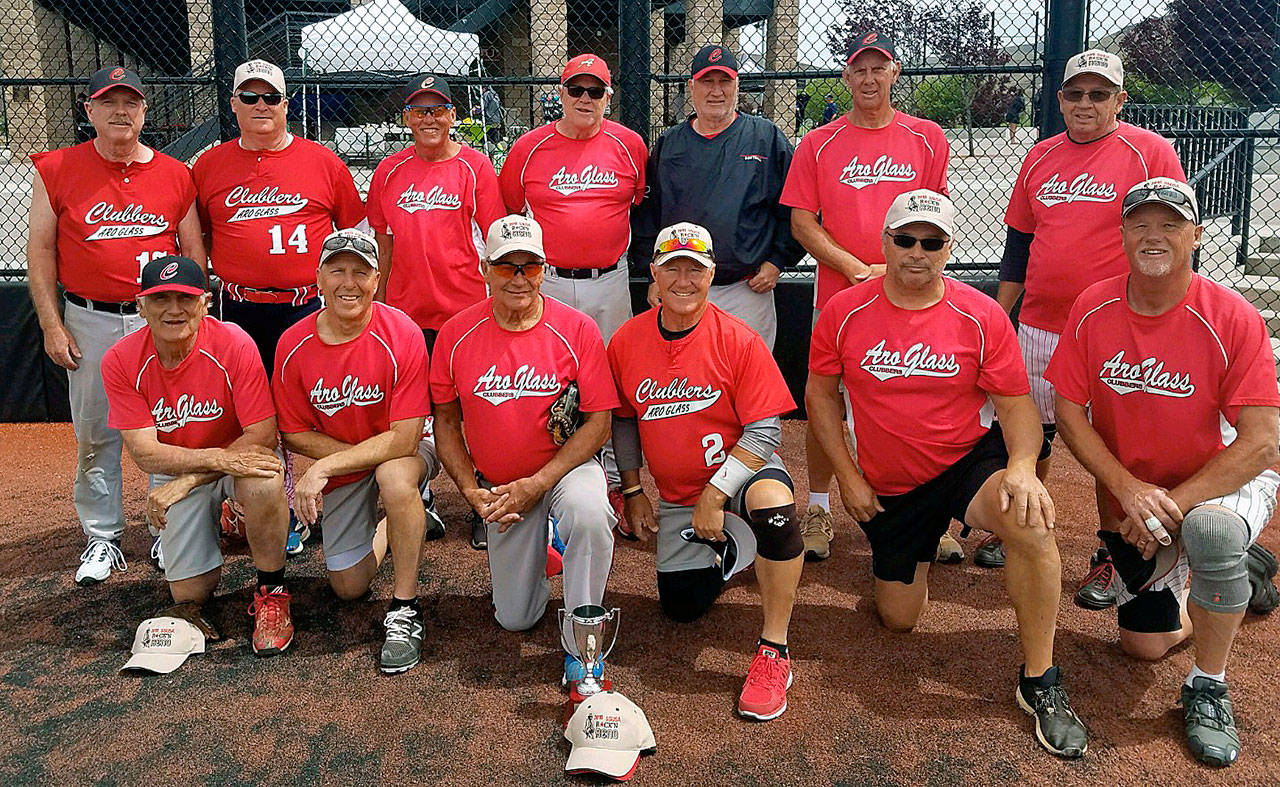ABERDEEN — The players have aged a bit since the Aro Glass Clubbers first took the field in 1969, but for the team’s original members, the game never gets old.
The Clubbers have been a force on the slow pitch softball tournament circuit since their inception in 1972, and the players who were college underclassmen at that time are still playing the game with a Clubbers logo on their jerseys, nearly 50 years since the team first set foot on the diamond.
Recently, some of the Clubbers’ most experienced players saw success when they won the Oregon Master’s Tournament with a 5-1 record July 10-12.
Wayne Ross, who has been playing for the Clubbers since its inception, led the team with an .846 batting average.
Ross said he and his fellow classmates were introduced to the game while they were at Grays Harbor College, when a former local slow pitch player gave away his equipment before enlisting in the army.
“A guy came to Grays Harbor College and brought some old bats, some balls and some ugly uniforms and he says ‘I’m going to the army if you want to have a team,’ and that’s how we started,” Ross said.
The Aro Glass Clubbers, who were then sponsored by Upland Cedar, played in their inaugural season in 1969 and within a few years developed into a formidable team in the region.
Arguably one of the biggest moments in the team’s history was the 1972 regional championship game played at Olympic Stadium.
Ross said his team was considered to be an underdog going into the game and, in addition to winning, was impressed by the community support that day.
“To think back in 1972 that 1,500 people would watch guys play slow pitch is unbelievable,” he said. “That year we went on to win that and I think we were the only team from the area to win that title.”
Softball brought the community together that day and playing on the team helped Mike Hatley get closer with some guys he said he never would have met.
Hatley, who hails from Aberdeen, didn’t grow up associating with anyone from Hoquiam. He said he is thankful for the way the game has brought him closer to his neighbors from the other side of Myrtle Street.
“When we were growing up we hardly associated with anybody across Myrtle Street. That’s the dividing line between Aberdeen and Hoquiam and we were big-time rivals,” he said. “Between Wayne Ross and Bob Paylor, who have become very good friends of mine, I would have never become friends with them if we didn’t play softball.”
Since celebrating that regional championship victory more than 40 years ago the team has won nine Washington state titles and has competed in tournaments across the western United States.
Ross doesn’t have plans of retiring from slow pitch any time soon and regularly plays in Arizona with another senior league team to stay sharp when the Clubbers have a break between tournaments.
“I really got into the game and it was something that I loved doing and I still have that passion for,” he said. “I play 250 games a year down here in Arizona and up in the Harbor. It’s something I just enjoy doing.”
As the team ages and gets moved into different groupings, players from outside of Grays Harbor donning the Clubbers uniform have become more common.
With the team’s original members now in their mid 60s, the Clubbers play in a 65-and-over division and pull from other areas such as Renton to keep the roster full.
Keeping a full roster is one thing, keeping players healthy is another.
Bob Paylor, who was part of the team’s original roster, said the short-term discomfort after a game hasn’t deterred him from his long-term goals.
“Athletically, everybody’s just day-to-day. You wake up some mornings and you can’t go do it,” he said. “Long term, my plan is to play as long as I can. There’s a 70-and-over group, an 80-and-over group and an 85-and-over group. So who knows? Maybe we’ll play in the 90-and-over group some day.”
At this point in his career, Paylor said conditioning off the field is just as important as what they do on the field.
“It hurts to play, especially if you’re going to play a couple of games a day. It takes a physical toll for me and it takes several days after a weekend trip to heal up,” he said. “We all go to the gym in the winter and we work on our conditioning.”
The conditioning comes in handy with the Clubbers playing in one of the higher skill level divisions for their age group.
Hatley noted that even though everybody is struggling to stay in playing shape, bigger teams at tournaments can still put runs on the board.
“You still have to have a lot of really good players to stay competitive,” he said. “There’s some really good players. You’d be amazed how good some of the people are at their ages. Especially the higher up you go. It’s amazing how good these players are.”
The Clubbers still find ways to win despite dealing with stiff competition on game day and stiff backs the day after a game, but it’s not really about the wins and losses for this core group of players that have shared the diamond with each other for almost 50 years.
Paylor said his friendship with his teammates means more to him than anything the Clubbers have accomplished at any tournament.
“Every little kid’s dream is to play baseball and to be able to do it with your friends,” he said. “To be able to do that and meet some great people along the way has probably been the highlight of all of it.”



